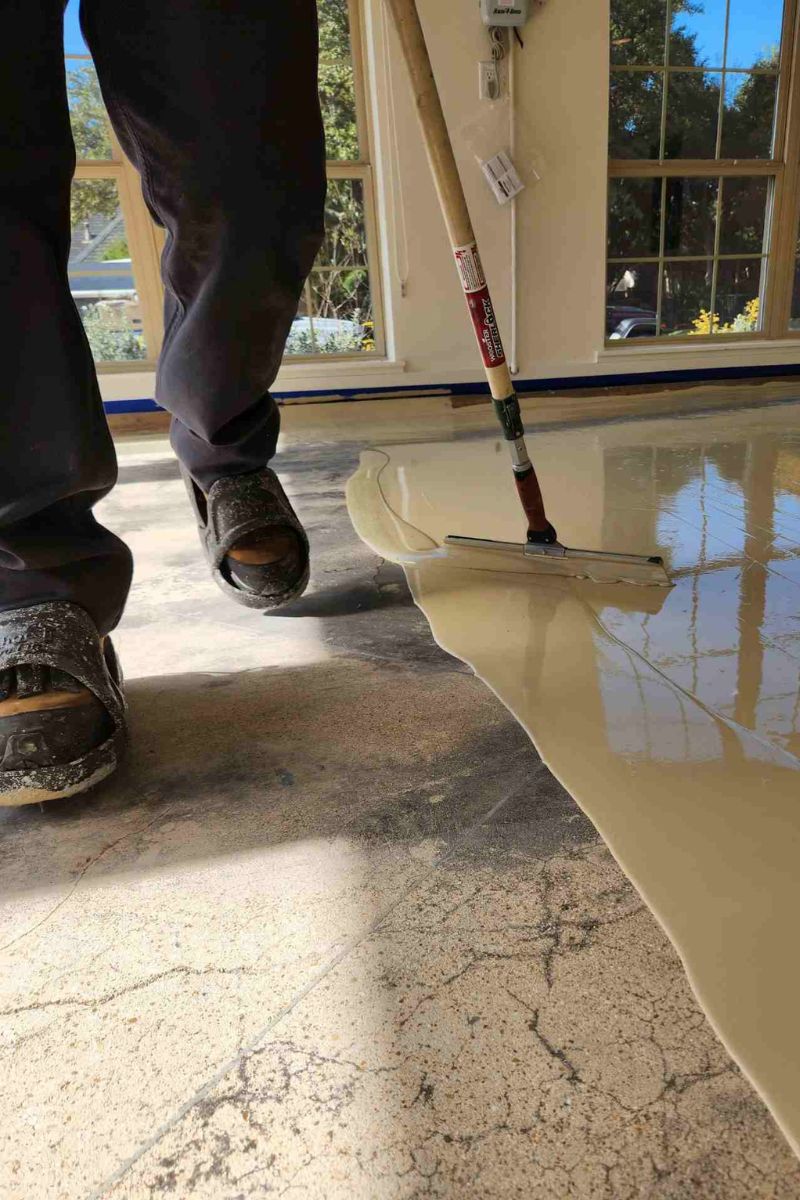
Your garage floor – often overlooked but brimming with potential.
Picture a garage that not only stores your stuff but looks clean and polished. The secret? Garage floor paint. More than a pretty face, it shields against stains, cracks, and daily wear.
Let’s dive into an easy guide on choosing the right paint for your garage floor. From benefits to types, assessing needs, and finishing touches – we’re on a journey to transform your garage.
Your garage floor is subjected to a myriad of challenges – from oil spills and vehicle traffic to the impact of tools and equipment. Garage floor paint is more than a cosmetic enhancement; it serves as a robust shield for your concrete surface (How to resurface concrete floors). Imagine a protective layer that repels stains, resists cracks, and stands resilient against daily wear and tear. The application of garage floor paint is akin to providing your garage with a durable armor that not only looks good but significantly enhances its performance and longevity. The advantages extend beyond aesthetics to practicality, offering a floor that is not only visually appealing but also easy to clean and maintain.
Not all garage floor paints are created equal, and understanding the unique qualities of each type is essential for making an informed choice. While epoxy paint boasts a glossy finish and exceptional chemical resistance, making it ideal for high-traffic areas, polyurethane paint offers flexibility and a smooth matte finish, suitable for spaces with temperature variations. However, the pinnacle of quality in garage floor coatings is polyaspartic floor coating. Renowned for its rapid cure time, exceptional durability, and resistance to UV rays, polyaspartic coating sets a new standard, ensuring a garage floor that remains in peak condition for an extended period.
Before delving into the world of paints, it’s crucial to assess your garage’s specific requirements. Factors such as the size of your garage, its intended use, and the current condition of the floor play a pivotal role in selecting the most suitable paint. Tailoring your choice to meet these unique needs ensures a more effective and long-lasting solution.
Selecting the color of your garage floor is not merely a matter of aesthetics; it influences the overall ambiance of the space. Light colors reflect more light, creating a brighter atmosphere and making dirt less noticeable. In contrast, dark colors may hide stains but could potentially make the space feel smaller. Striking the right balance between aesthetics and practicality ensures that your garage not only looks visually appealing but also meets your functional needs.
Achieving a flawless finish starts with thorough preparation. Each step is crucial in ensuring the longevity and effectiveness of the paint application. From cleaning and degreasing to addressing cracks and selecting the right primer, the preparation process sets the stage for a successful garage floor painting project. Notably, polyaspartic floor coating stands out in this phase due to its compatibility with various surfaces and rapid cure time, streamlining the preparation process for those seeking efficiency without compromising quality.
With the groundwork laid, it’s time to apply the paint. Following the manufacturer’s instructions diligently is paramount for achieving the desired results. Utilizing the right tools, whether brushes or rollers, ensures an even application, contributing to a professional finish. Adequate ventilation is crucial during the painting process, emphasizing the importance of keeping garage doors open. For those aiming for the pinnacle of quality, polyaspartic floor coating proves advantageous. Its self-leveling properties and rapid cure time facilitate a smoother application, resulting in a professional finish that speaks volumes about the transformation of your garage.
Even with meticulous planning, occasional issues may arise during or after the painting process. Bubbles, blisters, uneven coatings, or color irregularities are common challenges that can be effectively addressed. Understanding these potential problems and their solutions empowers you to maintain a garage floor that remains a source of pride. The versatility of polyaspartic floor coating extends to troubleshooting, minimizing issues such as peeling or chipping and providing a reliable, long-lasting solution.
To elevate your garage floor to the next level, consider finishing touches that enhance both aesthetics and functionality. Adding non-slip additives improves safety, especially in high-traffic areas. Topcoats provide an additional layer of protection, extending the life of your paint and maintaining its pristine appearance. Regular maintenance is crucial, and with polyaspartic floor coating, this becomes a seamless process. Its resistance to wear and tear, UV rays, and chemicals ensures that your garage floor remains polished and attractive with minimal effort, offering a long-lasting solution for those who seek excellence in garage flooring.
Mygaragefloors.com is an online platform with in-house installers dedicated to helping homeowners upgrade their garage floor with a superb Polyaspartic floor coating at the lowest price in the nation.
Stop wasting time on sales meetings.
Save your time and avoid their commission. Get your garage floor coatings installed today at the lowest price.
Check pricing
469-990-9990
Mygaragefloors.com is an online platform with in-house installers dedicated to helping homeowners upgrade their garage floor with a superb Polyaspartic floor coating at the lowest price in the nation.



Lots of companies claim to use Polyaspartic, but they only apply it for the final coat.
Using a mix of Epoxy or Polyurea for the base coat can lead to yellowing and peeling over time.
Insist on a full Polyaspartic system for both base and top coats.